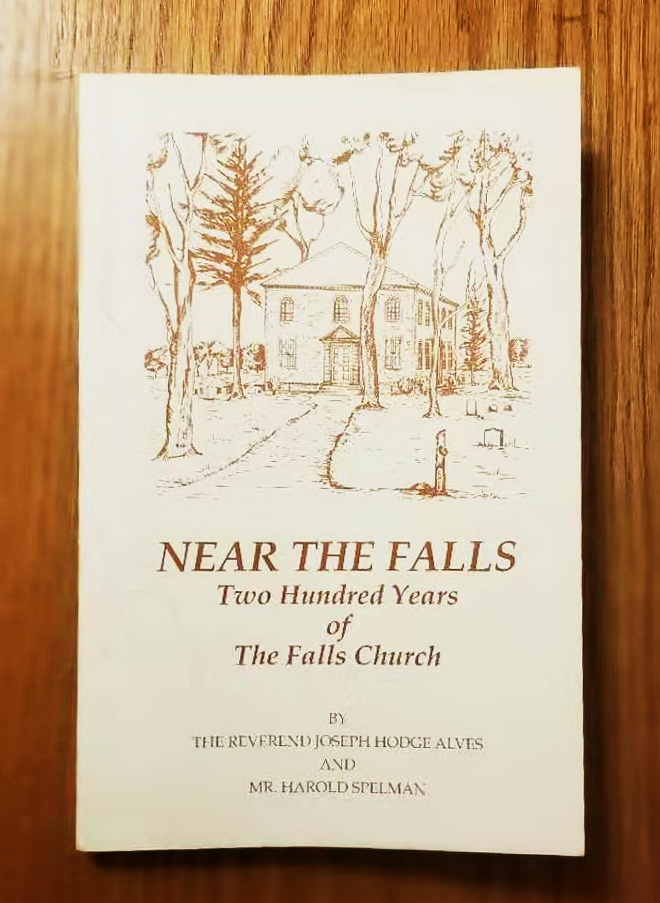See related blog here.
-
J. H. Alves and H. Spelman (1969). Near the Falls: Two Hundred Years of The Falls Church.
A few basic facts.
The County of Alexandria, D.C., which is now Arlington, was ceded to the Federal Government in 1801. It was retroceded to Virginia in 1846. The City of Alexandria was incorporated in 1852, and nearly 100 years later in 1948 the town of Falls Church, named after “the church on the road to the Falls,” became the City of Falls Church.
- Melvin Steadman [in his book, Falls Church by Fence and Fireside] points out that at the time the church was founded there was “nothing in this area except plantations and small farms, and here and there an occasional Ordinary (tavern). The road to the Little Falls of the Potomac was intersected by the road from Alexandria to Leesburg, once known as Middle Turnpike, and now known as Leesburg Pike (Broad Street). Is was at this crossroads about three miles distant that the Falls Church was built.” (p 2)
Vestry of a Parish
- The Vestry was by law responsible for the administration of religion and the moral health of all people in the Parish. They must provide a minister, build and maintain churches, provide for the poor, the sick and orphans. Make presentments to the Country Court in adultery cases, appoint processioners to establish boundaries of patented lands, and levy a poll tax on all tithables to pay for these costs. All white males over 15 years and all Negro males and females over f15 were tithables. After being elected, they filled vacancies that occurred in their membership. The General Assembly provided for new vestry elections when dividing a parish and could do so at other times. The Bishop of London had spiritual authority over all the colonies, including the licensing of ministers and the sending of missionaries. Upon request of the Vestry the Royal Governor could “induct” a minister into a parish, after which he was irremovable except for cause. A minister’s salary was set by law at 16,000 pounds of tobacco per year with the use of a glebe. (A glebe was a farm set aside for the use of the minister of a parish.) Tobacco was the cash crop, and it was inspected by County inspectors at warehouses to which every producer must bring it before offering it for sale. Taxes were levied and paid in tobacco. (p. 3)
George Washington as Vestryman
- At a Vestry held on October 25, 1763, the levy was laid and “ordered that George Washington, Esq. be chosen and appointed one of the vestrymen of this Parish in the room of William Peak, gent. deceased.” Colonel Washington took the required oaths the Fairfax County Court House, on February 15, 1763, and attended his first Vestry which was held at the Falls Church. (p 9)
The next Vestry was held October 3, 1763. They laid the levy, including 30,000 lbs. “towards building the Falls Church.” … “Ordered that Geo. William Fairfax and George Washington Esq. be appointed Church Wardens for the ensuing year. Ordered that the Vestry meet at Alexandria the Third Monday in March next… to agree with workmen to undertake the building a church at or near the old Falls Church and that the Church Wardens advertise the same… for six weeks…. Apparently no bidders showed up, but on March 20, 1764, the Wardens advertised again for bids to be received in June at The Falls Church. Again no bidders appeared. This was Washington’s last official act connected with The Falls Church. At a Vestry on October 9, 1764, the levy was laid, including “For building churches in the Parish 20,000 lbs. tobacco. (p10)
James Wren
- At a Vestry held October 16, 1766, Adams and Dalton were appointed Church Wardens… and “Ordered the advertisement of the building of a church at The Falls Church 2400 square feet… to be raised to admit of galleries.” … They also ordered the advertisement of the glebe for the same date. A Vestry held November 5, appointed James Wren as Vestryman…. (p 12)
In accordance with the advertisement, James Wren… submitted a plan and a proposal to build the Falls Church…. The Wren Family claim descent from Sir Christopher Wren, according to Melvin Steadman in his Falls Church by Fence and Fireside….
During 1767 James Wren must have been engaged in brick making. The bricks were made of clay dug, mixed, molded and burned nearby. (p13)
Col Wren was ordered by a Vestry on February 8, 1768, “to fix the church as near to the northside of the old church so that it fronts directly south.” (p14)
As work progressed on the new church, the Wardens were ordered on November 29, 1768 to “advance to Mr. James Wren, one of the undertakers for building the church at the Falls, 50,000 pound of tobacco towards his payment to be made in the year 1769 and at the same time give bond that in case of the purchase of the glebe and money is wanting that he is to pay it upon demand. It is further ordered that the collector pay Mr. James Wren three thousand pounds of tobacco under the payment to be made in the year 1769. (p 14)
The new Falls Church must have been completed by late fall for we find that a Vestry on November 28, 1769, laid a levy, which included “19,996 lbs. tobacco for Public Services” which could be used toward paying the balances yet due on the churches or for buying a glebe.” (p 15)
First published: 2019/12/25
Latest revision: 2020/03/27
